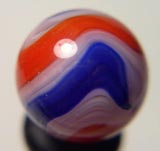The Master Marble Company was founded in 1930 in Clarksburg, West Virginia, by former employees of the Akro Agate Company. Boxes from this company had the company's name and were labeled "Master Made Marbles" with three joined letter "M"s. The company closed in 1941, and one of the former owners purchased the equipment to form The Master Glass Company, which remained in business until 1973. Because many Master Marble and Master Glass marbles are so similar, they are sometimes lumped together. As a generally rule, while Master Marbles’ colors are fairly unique, they are generally duller than Akro Agate marbles, and tend to have "fall colors.". Master Glass marbles are even more muted, and many of the later company's marbles had dark transparent glass.
Both Master companies used machinery that was similar to Akro Agate’s. However, the company never adopted Akro Agate's "Freese improvement" manufacturing technique that eliminated the cutoff marks at the poles of the marbles. Thus, Master marbles have a unique pattern at either end, often with a U-shaped crimp at one end, and a V-shaped crimp at the other end, often with feathering or an eyelash shape crimp mark at one or both ends.
Several types of Master Marbles are collected. In the 1930's, the company made translucent opaque marbles in blue, aqua, green, white, or lavender that are valued today because of their distinct colors. The company made a Sunburst marble with internal filaments meant to imitate antique onionskin marbles.
Master Marble Company also made some patch marbles that are collectible. These patches were marketed under a variety of names, including Meteor (wispy translucent patch on opaque base), Comet (opaque patch on opaque base), and Cloudy (translucent patch on translucent base). Many of these marbles are similar to, and confused with Akro Agate patches like Moss agates.
Master Glass Company made a type of brushed marbles that have a veneer of white glass that appears to be brushed onto a third of the marbles. Sometimes Sunbursts are found brushed, although the glass in these marbles later era Sunbursts is often dark, so it is hard to see the filaments.
Master Glass cat’s-eyes are typically a single-color with three translucent vanes in clear glass, and there is another type sometime called a cat's eye that has single flat vane in clear glass.





 Buy Akro Agate Popeye marbles on eBay!
Buy Akro Agate Popeye marbles on eBay!